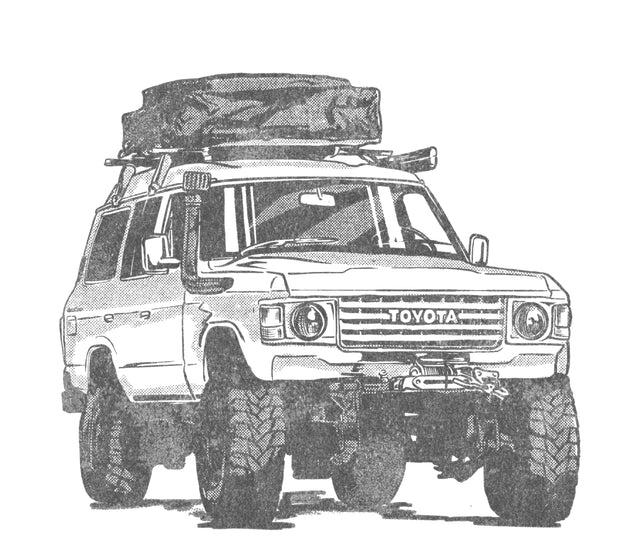Toyota Land Cruiser
In 1950, the Korean War created demand for a military light utility vehicle. The U.S. government tasked Toyota to manufacture a Jeep-like vehicle and ordered 100 with the Willys specifications. Toyota developed the BJ prototype in January 1951, a vehicle similar to the British Land Rover Series 1 developed in 1948. The Jeep BJ was larger than the original U.S. Jeep and more powerful courtesy of its Type B 3.4 litre six-cylinder OHV Four-stroke petrol engine which generated a power output of (84 hp). It had a part-time four-wheel drive system like the Jeep. Unlike the Jeep, the Jeep BJ had no low-range transfer case. In July 1951, Toyota's test driver Ichiro Taira drove the Jeep BJ prototype up to the sixth stage of Mount Fuji, the first vehicle to climb that height. The test was overseen by the National Police Agency (NPA), which as a result, placed an order for 289 of these off-road vehicles, making the Jeep BJ their official patrol car.
From 1951-1953, Toyota manufactured a small volume to order. In 1953, wider production of the "Toyota Jeep BJ" began at their Honsya Plant with body assembly and painting done at Arakawa Bankin Kogyo KK, later known as ARACO (now an affiliate of Toyota Auto Body Company).
The next year, the name "Land Cruiser" was coined by the technical director Hanji Umehara. The name had already been used on the Studebaker Land Cruiser which was produced from 1934 to 1954. The 92 kW (123 hp; 125 PS), 3.9 litre Type F gasoline engine was added to the Land Cruiser range for the first time, originally only in the fire engine chassis.
Toyota Land Cruiser FJ43
Toyota Landcruiser has had numerous designations over time. The first series of letters indicates engine size and fuel use. Most Land Cruisers begin with "F" indicating the petrol fuel use. Other Landcruiser begin with "B" or "H" indicating diesel.
Toyota offered the FJ43 as a slightly extended version of the more common FJ40 truck, though it was never sold in North America. A 2-door model, the FJ43 offered a forward-facing rear bench seat. Most had soft tops, and some aftermarket hardtops were also produced. Full steel hardtops are very rare and often custom made.
Pickup and Wagon Versions
The FJ45 pickup and wagon version expanded the 40-Series Land Cruiser. Offered in LWB and SWB version, some had removable tops and some did not. A special FJ45LV station wagon was also produced.
The FJ55 station wagon made its introduction in 1967 was produced until 1980. It is famous for its two-tone paint and unusual front-end styling. The trucks are often dubbed the 'Iron Pig,' and they have a tendency to rust so clean versions are highly sought after.
Toyota refers to the FJ55G and FJ55V as the first "real" station wagon in the Land Cruiser series. It was the first Land Cruiser to have fully enclosed box frame members. It is the only one of all the Land Cruiser wagons sold in the U.S. not to have hatch and tailgate in the rear, but rather a tailgate only with an electrically operated window that can be retracted into the tailgate.
J60-Series (1980–1990)
The Land Cruiser 60 series was produced from 1980 through 1990 for most markets, but continued production until 1992 at the Cumana Plant in Venezuela for their local market. It is a front engine, four-door wagon with room for five to eight occupants.
70-Series (1984 – Present)
The 70-Series Land Cruisers began production in 1984 and continue to be produced today. While the 70-Series replaced the 40 Series in catering to utility and off-road needs, the 60 Series (and later the 80, 90, 100, 120, 150 and 200 Series) became more geared toward comfort. Despite major changes in styling and numerous technological updates, the 70 Series kept the off-road capabilities and durability of the 40 Series. The 70 Series was marketed throughout the world, except in countries like India, the United States, Mexico, Brazil and Korea where they were imported and put into commercial or private use.
80-Series (1990–2008)
The FJ80 was the first Land Cruiser to ride on coil springs, and it introduced a new level of comfort to the FJ while retaining its toughness. Solid axles and locking differentials remained.
The Land Cruiser 80 series debuted in October 1989 at the Tokyo Motor Show and launched in early 1990. It had swing-out back doors, which were replaced by a tailgate and hatch in 1994. The Land Cruiser was nicknamed the Burbuja (Bubble) in Colombia and Venezuela due to its roundness. The J80 initially came in two versions in these countries: the fully loaded VX and an entry level model that included a vinyl interior with optional air conditioning. In 1996, the entry model received upgrades to a medium equipped model named Autana, including cloth upholstery, standard air conditioning and power driver seat.
Toyota Land Cruiser 100-Series (1998 – 2007)
The 100-Series Land Cruiser had a production run from 1998 to 2007, following the 80-Series. It was the first Land Cruiser with independent front suspension and V8 power. These are very popular for all-round utility and overland use, and clean and well-modified examples are highly sought after in today's market.

